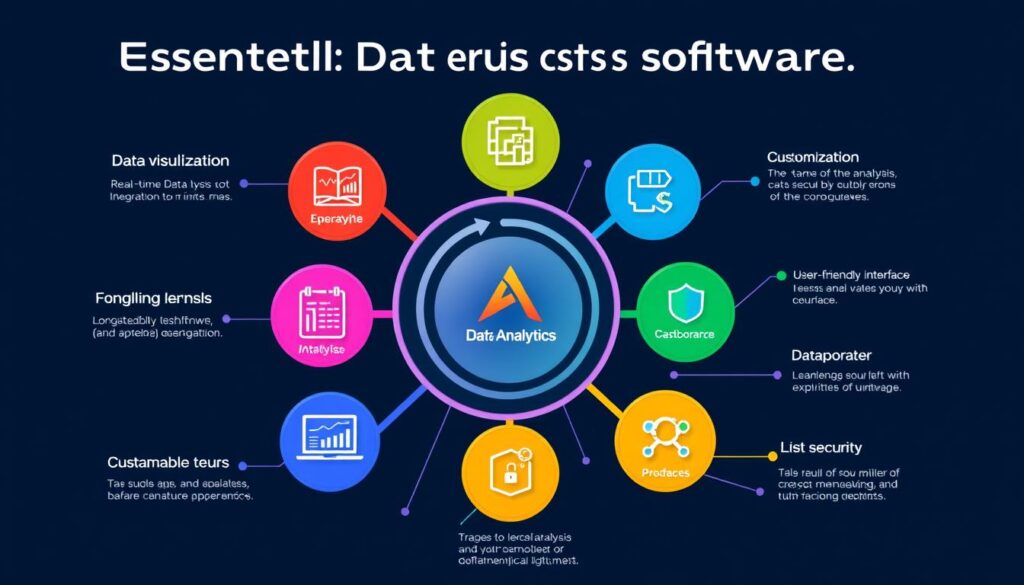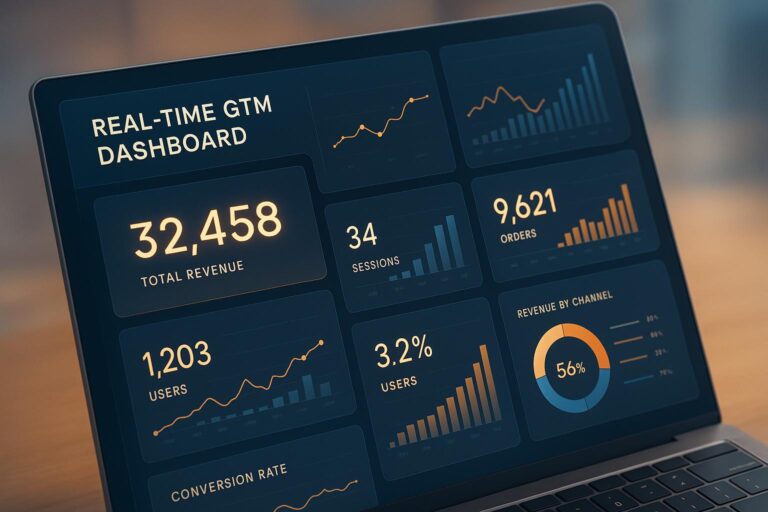In today’s world, businesses are flooded with information. The skill to pull valuable insights from large amounts of data is crucial. Data analytics software development has become a key player. Organizations aim to transform raw data into impactful decisions. Critical KPIs, improving data storage, and using advanced analytics tools shape modern business strategies.
About 40% of an executive’s time focuses on decision-making. This can be enhanced with analytics software. Look at Lufthansa, which boosted its efficiency by 30% using Tableau. This shows the strong results that advanced tools can bring.
There are many analytics tools available, from Python’s AI to RStudio’s statistical analysis. Knowing what’s out there is critical. For businesses seeking to improve and stay ahead, picking the right analytics tools means securing future success. The blend of new tech, strategic knowledge, and agile data use is the future of business.
Key Takeaways
- The role of data analytics software in enhancing business insights and data-driven decisions cannot be overstated.
- Advanced data analytics solutions empower businesses with faster, more efficient decision-making capabilities, exemplified by Lufthansa’s 30% efficiency surge.
- Tools like Tableau, Python, and RStudio are instrumental in translating complex data sets into accessible, actionable business knowledge.
- The versatility of software development in Python and RStudio’s powerful statistical packages supports a tailored approach to each organization’s unique data needs.
- Businesses utilizing data analytics tools have demonstrated superior product development, customer acquisition, and operational efficiency.
- Strong need for analytics tools to include real-time dashboarding and reporting to foster interdepartmental collaboration and information sharing.
- Choosing the appropriate data analytics software involves an evaluation of both the technological capabilities and the pricing models suitable for diverse business scopes.
Understanding Data Analytics and Its Importance
Data has grown rapidly, making data analytics crucial in many fields. Companies face huge data volumes and must make smart choices. Predictive analytics software helps use this data well, improving business intelligence and decision-making.
Definition of Data Analytics
Data analytics means analyzing data to find useful insights. It helps now and prepares for the future. It enables companies to plan and act with insight, using different analysis types.
Key Benefits for Businesses
Data analytics enhances how a company works. It improves operations and how customers experience services. Companies like BT Group and Flutter Entertainment have seen big benefits from analytics. They’ve improved their work and how they connect with customers. GE Digital used analytics to make better products faster.
- Better customer understanding from varied data, leading to improved services.
- Efficiency in work processes, helped by real-time analytics.
- Quicker responses to market changes, aiding marketing and product suggestions.
Trends Influencing Data Analytics
The field of data analytics keeps changing with new technology. Machine learning and AI have made analytics even better. This improves predictions on what customers and markets will do. Having data right away is also becoming more important, especially in fast-moving sectors.
Data’s growth makes strong analytics tools key for businesses wanting to stay ahead. Advances in predictive analytics software will be vital for future business intelligence and decision-making.
Essential Features of Data Analytics Software
Choosing the right data analytics software is pivotal for businesses. It helps unlock the full potential of their data. Key features like easy-to-use interfaces, strong data integration, and flexible customization are crucial. These elements help build a smooth business intelligence system that meets different needs. Let’s dive into these important features that make data analytics software efficient and scalable.
User-Friendly Interface
A user-friendly interface makes learning data analytics software easier. This is true for both technical folks and those who aren’t tech-savvy. Having an intuitive interface means faster onboarding. This lets people quickly learn and keep using the software. Making data easy to access and understand allows everyone in a company to find valuable insights.
Data Integration Capabilities
Data integration is key in analytics platforms. It allows merging different types of data, like spreadsheets and social media content. This mixing is vital for deep, contextual insights. Good integration makes the software versatile in handling data, helping businesses use all their data well. Adding advanced software like machine learning can make data insights even better and automatic.
Scalability and Customization
Scalability is essential for data analytics software, ensuring it can grow with your business. It can improve handling data or work with new tools. Customization lets businesses adjust the software to their needs, including specific dashboards or compliance features. The right software grows with you and fits what your business does.
In conclusion, businesses should find data analytics software with great data integration, easy interfaces, and the ability to scale and customize. These characteristics help build a strong business intelligence system. It will support not just current tools but also adapt to future needs. This fosters business growth and better decision-making.

Popular Software Solutions for Data Analytics
Data is growing fast, and businesses need good analytics tools more than ever. Choosing the right software can make analyzing huge datasets much easier. Tableau, Microsoft Power BI, and Google Analytics are top options. Each one offers special features for different needs in data analysis.
Tableau
Tableau is known for its strong AI and real-time visualization. Users can make interactive dashboards to see data trends easily. But, it’s not the best for complex SQL queries. This could be a downside for users who need to do detailed data work.
Microsoft Power BI
Microsoft Power BI is great for those who already use Microsoft products. Its easy-to-use interface fits well in many businesses. It connects with lots of data sources and offers broad business intelligence tools. Plus, its focus on real-time visualization helps companies make quick decisions.
Google Analytics
Google Analytics turns data into useful insights, especially for online activities. It provides detailed reports on website traffic and user actions. These insights are key for digital marketing. Google Analytics also works well with other tools, which boosts its value for data analysis.
These platforms show a move towards dynamic, real-time data tools in business. Picking the right software helps companies understand the market and foresee trends. For more info on these tools, check out AI-Agent analysis tools. This resource gives a closer look at AI data solutions.
Comparing Cloud-Based vs. On-Premises Solutions
Businesses looking to improve operations face a big choice: cloud-based or on-premises solutions. Both have unique benefits and challenges. These differences affect their usefulness in various business situations.
Advantages of Cloud-Based Analytics
Cloud-based solutions are known for their flexibility and scalability. This is key in the fast-paced business world of today. A major plus is how cost-effective they are. Companies can adjust their resources based on current needs without heavy initial costs. This helps manage expenses better.
They also make it easier to connect with different data sources worldwide. This boosts teamwork and supports those working remotely. Overall, productivity sees a nice increase.
- Scalability: Adjust resources as needed without long-term commitments.
- Cost-effectiveness: Lower initial costs and pay-as-you-go pricing models.
- Accessibility: Facilitates remote data access and collaboration.
Disadvantages of On-Premises Software
On-premises software gives businesses direct control over their data solutions. This is very important in fields with strict privacy rules. Companies manage everything from data storage to security. This helps protect against data breaches. But, choosing on-premises means facing higher upfront costs for setting everything up. And there are ongoing costs for maintenance too.
It’s also harder to scale up as the business grows. Any expansion requires more investment. This limits flexibility compared to cloud options.
- High initial investment: Requires significant capital for infrastructure setup.
- Maintenance costs: Ongoing expenses for system upgrades and repairs.
- Scalability challenges: Limited flexibility to scale quickly based on business growth.
Both cloud-based and on-premises options have good and bad points. Cloud solutions are easy to use, scalable, and budget-friendly. They suit businesses that need strong, adaptable data software. On-premises solutions give more control over data and security. But they cost more and are harder to scale. The right choice depends on your business needs, rules you must follow, and your budget.
Best Practices for Implementing Data Analytics Software
Effectively implementing data analytics software boosts operational productivity. It aids decision-making in organizations. This involves more than installing software; it’s about strategic planning and aligning it with the business’s goals.
According to a recent survey, 92% of software development companies are utilizing data analytics tools. This shows how vital these tools are in improving operations and decisions. It’s important to have a thorough implementation plan.
Identifying Business Objectives
Defining business goals is the first step in using data analytics software. Goals can range from better customer retention to improving the supply chain. Having clear targets allows for focused data analysis. This supports smarter decisions and boosts efficiency.
Training and Support for Teams
Training and supporting teams are crucial for getting the most from data analytics software. A Gartner report says by 2023, 90% of software projects will rely on data for decisions. Training should teach both tool use and data interpretation. This ensures teams use the software effectively every day.
Ensuring Data Quality and Security
High-quality, secure data is essential for successful data analytics. Implementing policies and mechanisms protects sensitive info. These practices also maintain data’s integrity. Good data management boosts data tool performance. It improves data governance in an organization.
Following these best practices enhances the strategic use of data analytics software. It improves productivity and decision-making in all company areas.
Future Trends in Data Analytics Software
Technology is changing fast, and with it, predictive analytics software and artificial intelligence in analytics are set to make big changes in how we analyze data. These changes come as machines learn better, making data handling more automated and efficient.
Rise of Artificial Intelligence and Machine Learning
The impact of artificial intelligence (AI) in analytics can’t be overstated. Companies use AI-driven analytics to get deeper insights and work more effectively. AI for predictive analytics is changing how firms predict future trends, leading to better scalability and productivity.
Machine learning advancements stand out by improving how small data sets are handled. This increases the speed at which data analytics platforms deliver insights and investment returns.
The Role of Predictive Analytics
Predictive analytics software excels in forecasting future trends and consumer actions. It uses past data to predict what might happen next, which is crucial for planning, risk management, and staying ahead of competitors.

Also, there’s a growing use of technologies like hybrid cloud solutions and edge computing alongside predictive analytics. These technologies make data solutions more affordable, scalable, and secure. They improve how we manage huge amounts of data.
The use of predictive analytics software is expanding across business areas. It helps in predicting customer buying patterns and improving business strategies. There’s also a growing interest in synthetic data to make AI models more robust and varied.
This move towards smarter, more connected analytics systems highlights the vital role of predictive analytics software in future business strategies. It’s proving to be essential for companies looking to make quick, data-driven decisions amidst new market challenges.
Making the Right Choice for Your Organization
Choosing the right software for data analytics is crucial for your team’s future. It’s not just about the benefits now. It sets your organization on the path to long-term success. In fields like insurance, data is very important. Having the skills to use this data can improve decisions, competitiveness, and growth. The best tools turn raw data into clear, useful insights. This affects lots of areas, from managing agencies to rating systems. Without good technology, organizations may not reach their full potential.
Evaluating Software Providers
Finding top data analysis tools means asking important questions. The topics should range from integrating existing system data to enhancing sales strategies. They should also include review of overall health of the agency. A key feature to look for is customized reports. They focus on specific performance areas. Among surveyed businesses, 42% put scalability and performance first. Meanwhile, 55% believe in integrating with current systems. Thus, pick a solution that grows with your data and works well with your existing technology.
Considering Budget and Resources
Money is a big factor, affecting 65% of organizations when they pick software. The aim is to get a good return on investment from analytics software. Make sure your choice is affordable now and in the future. This includes costs for licenses, updates, and possible expansion. Remember, investing in this type of software should increase efficiency and profits. It achieves this by turning data into smart decisions.
Gathering User Feedback and Reviews
Feedback from current users is very helpful in judging a software’s value. Up to 78% of companies value features like visualization and reporting. They’re essential for sharing insights. Looking at user feedback helps you understand how the software performs in real life. It helps you see if it meets your needs. With 38% of businesses feeling swamped by options, the right reviews can lead you to a practical, well-liked solution.
FAQ
What is the definition of data analytics?
Data analytics means looking closely at raw data. Its goal is to find insights and support making decisions. It involves steps like descriptive and diagnostic analysis, along with predictive and prescriptive analytics.
What are the key benefits of data analytics for businesses?
The benefits are big. They can make products better, work more efficiently, keep customers happy, and stand out against competitors. It helps companies make smart choices based on data.
What trends are influencing the field of data analytics?
Big trends include using predictive analytics, AI, and machine learning. These tools help in making forecasts. They provide automatic insights that improve decision-making.
What essential features should data analytics software have?
Important features are an easy-to-use interface, solid data integration, and the ability to grow with your business. Plus, good software often has data visualization and a full business intelligence setup.
What are popular software solutions for data analytics?
Tableau is loved for its visuals. Microsoft Power BI is user-friendly and works well with Microsoft products. Google Analytics is great for web analytics.
What are the advantages of cloud-based analytics software?
Cloud-based software is flexible and can grow with you. It’s cost-effective, simplifies sharing data, and allows working from anywhere.
What are the disadvantages of on-premises analytics software?
It gives you more control and can be customized. But, it might cost more at the start. Also, you need your own team to maintain it.
What are some best practices for implementing data analytics software?
Start by being clear about what you need it to do. Make sure everyone knows how to use it. Keep your data safe and high-quality.
How will artificial intelligence and machine learning impact the future of data analytics?
AI and machine learning will make predictive analytics even better. They’ll help create more detailed models. They also provide insights automatically. This supports smarter decisions and planning.
How should organizations evaluate software providers when choosing data analytics software?
Look at the provider’s success and customer support. Check if the software fits your needs. Think about the cost and what return you expect on your investment.
Why is considering budget and resources important when selecting data analytics software?
Picking software that fits your budget and resources means you can expect a good return. It avoids stretching your money and people too thin.
Why is gathering user feedback and reviews important in choosing the right data analytics software?
Feedback and reviews give real insights into how useful the software is. They help you choose something that meets your long-term goals.



